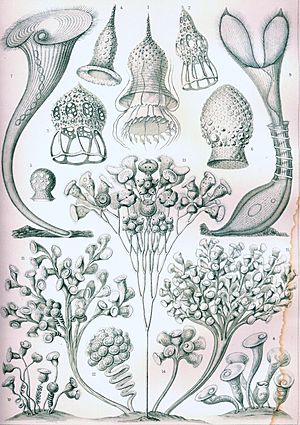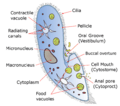Ciliate facts for kids
Quick facts for kids CiliatesTemporal range: Ediacaran - Recent
|
|
|---|---|
 |
|
| "Ciliata" from Ernst Haeckel's Kunstformen der Natur, 1904 | |
| Scientific classification | |
| Domain: | |
| Kingdom: | |
| Superphylum: | |
| Phylum: |
Ciliophora
Doflein, 1901 emend.
|
| Classes | |
|
Karyorelictea |
|
The ciliates are a group of protists characterized by the presence of hair-like organelles called cilia, which are identical in structure to flagella but typically shorter and present in much larger numbers with a different undulating pattern than flagella. Cilia occur in all members of the group (although the peculiar suctoria only have them for part of the life-cycle) and are variously used in swimming, crawling, attachment, feeding, and sensation.
Ciliates are an important group of protists, common almost everywhere there is water — in lakes, ponds, oceans, rivers, and soils. About 3,500 species have been described, and the potential number of extant species is estimated at 30,000. Ciliate species range in size from as little as 10 µm to as much as 4 mm in length, and include some of the most morphologically complex protozoans.
Contents
Feeding
Most ciliates are heterotrophs, feeding on smaller organisms, such as bacteria and algae, swept into the oral groove (mouth) by modified oral cilia. This usually includes a series of membranelles to the left of the mouth and a paroral membrane to its right, both of which arise from polykinetids, groups of many cilia together with associated structures. The food is moved by the cilia through the mouth pore into the gullet, which forms food vacuoles.
Feeding techniques vary considerably, however. Some ciliates are mouthless and feed by absorption (osmotrophy), while others are predatory and feed on other protozoa and in particular on other ciliates. Some ciliates parasitize animals, although only one species, Balantidium coli, is known to cause disease in humans.
Fossil record
Until recently, the oldest ciliate fossils known were tintinnids from the Ordovician Period. In 2007, Li et al. published a description of fossil ciliates from about 580 million years ago, in the Ediacaran Period.
Images for kids
-
Diagram of the ciliate Paramecium
See also
 In Spanish: Ciliophora para niños
In Spanish: Ciliophora para niños




